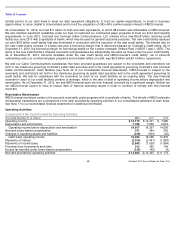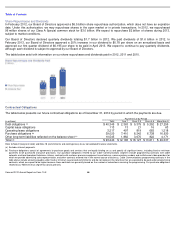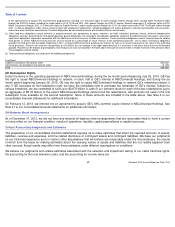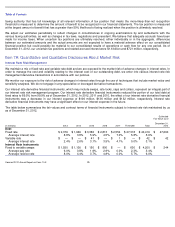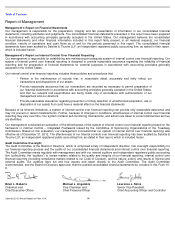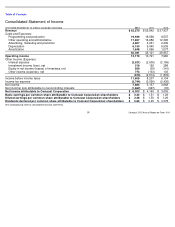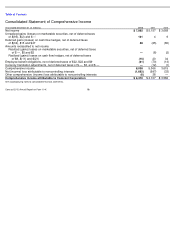Comcast 2012 Annual Report Download - page 72
Download and view the complete annual report
Please find page 72 of the 2012 Comcast annual report below. You can navigate through the pages in the report by either clicking on the pages listed below, or by using the keyword search tool below to find specific information within the annual report.
Table of Contents
Film and Television Costs
We capitalize film and television production costs, including direct costs, production overhead, print costs, development costs and
interest. We amortize capitalized film and television production costs, including acquired libraries, and accrue costs associated with
participation and residual payments to programming and production expense. We generally record the amortization and the accrued
costs using the film forecast computation method, which amortizes such costs using the ratio of the current period’
s actual revenue
to estimated total remaining gross revenue from all sources (“ultimate revenue”).
Estimates of ultimate revenue have a significant
impact on how quickly capitalized costs are amortized and, therefore, are updated regularly.
Our estimates of ultimate revenue for films generally include revenue from all sources that are expected to be earned within 10 years
from the date of a film’
s initial release. These estimates are based on the historical performance of similar content, as well as factors
unique to the content itself. The most sensitive factor affecting our estimate of ultimate revenue for a film intended for theatrical
release is the film’
s theatrical performance, as subsequent revenue from the licensing and sale of a film has historically exhibited a
high correlation to its theatrical performance. Upon a film’
s release, our estimates of revenue from succeeding markets, including
home entertainment and other distribution platforms, are revised based on historical relationships and an analysis of current market
trends.
With respect to television series or other owned television programming, the most sensitive factor affecting our estimate of ultimate
revenue is whether the series can be successfully licensed beyond its initial license. Initial estimates of ultimate revenue are limited
to the amount of revenue contracted for each episode under the initial license. Once it is determined that a series can be licensed in
subsequent platforms, revenue estimates for these platforms, such as U.S. and international syndication, home entertainment, and
other distribution platforms, are included in ultimate revenue. In the case of television series and owned television programming,
revenue estimates for produced episodes include revenue expected to be earned within 10 years of delivery of the initial episode or,
if still in production, five years from the delivery of the most recent episode, if later.
Capitalized film and television costs, as well as stage play production costs, are subject to impairment testing when certain triggering
events are identified. If the fair value of a production falls below its unamortized cost, we would record an adjustment for the amount
by which the unamortized capitalized costs exceed the production’
s fair value. The fair value assessment is generally based on
estimated future discounted cash flows, which are supported by our internal forecasts. Adjustments to capitalized film and stage play
production costs of $161 million and $57 million were recorded in 2012 and 2011, respectively.
Income Taxes
We base our provision for income taxes on our current period income, changes in our deferred income tax assets and liabilities,
income tax rates, changes in estimates of our uncertain tax positions, and tax planning opportunities available in the jurisdictions in
which we operate. We prepare and file tax returns based on our interpretation of tax laws and regulations, and we record estimates
based on these judgments and interpretations.
From time to time, we engage in transactions in which the tax consequences may be subject to uncertainty. In these cases, we
evaluate our tax positions using the recognition threshold and the measurement attribute in accordance with the accounting
guidance related to uncertain tax positions. Examples of these transactions include business acquisitions and disposals, including
consideration paid or received in connection with these transactions, and certain financing transactions. Significant judgment is
required in assessing and estimating the tax consequences of these transactions. We determine whether it is more likely than not
that a tax position will be sustained on examination, including the resolution of any related appeals or litigation processes, based on
the technical merits of the position. In evaluating whether a tax position has met the more-likely-than-
not recognition threshold, we
presume that the position will be examined by the appropriate
69
Comcast 2012 Annual Report on Form 10-
K






